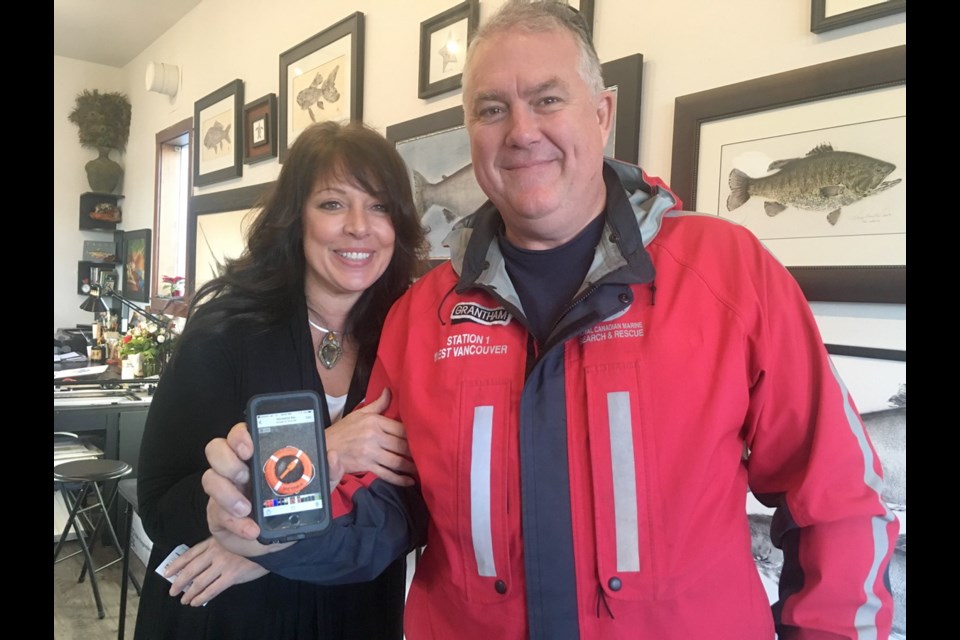In her sun-drenched Ladysmith art gallery, Mya DeRyan studied the faces of the four search and rescue volunteers who saved her life, five hours after she jumped into the frigid waters from a B.C. Ferries vessel.
The last time she saw them, on Oct. 30 at 10:45 p.m., the 52-year-old was being pulled into a rescue boat from the middle of an orange life ring, which had floated to DeRyan just as panic set in.
In an emotional reunion Sunday, the rescuers from Royal Canadian Marine Search and Rescue Station 1 in West Vancouver looked at DeRyan as if she might not be real, because her story of survival is remarkable, unprecedented and on the verge of impossible.
Bruce Falkins, who has been a search and rescue volunteer so long that there’s a class of vessel named after him, told DeRyan how unbelievable it is that she was found alive.
“For the last hour, we thought we were wasting our time,” said Falkins, who is mustachioed and grandfatherly, with thin wire-frame glasses and a kind smile. “Five hours, we thought we’d be recovering a dead person.”
Ian Grantham said search and rescue volunteers refer to a survivability formula, based on years of research, data and scientific evidence, as a guide for how long to search.
The limit for survivability in cold water is typically about three hours, so after five, crews were ready to call off their search. They steered the boat toward what they thought was an empty life ring and were stunned to find DeRyan in the middle.
Grantham’s first words were: “Holy s***, there she is.”
DeRyan brushed her hair out of her eyes, waved and smiled.
“There was a bit of well, not pandemonium, but excitement,” Grantham recalls.
Rob Alexander remembers saying: “We’ve been looking for you.”
DeRyan recalls that even in that moment of desperation, she responded “Who me?” with a tinge of sarcasm.
“I could feel your jubilation,” she said. “I could feel your compassion. I want you to know how comforting it was to be in your care.”
Shortly after emerging from the water, DeRyan was told her body temperature was 28 or 29 C, dangerously below the normal of 37 C.
“You felt like a steak that had been taken out of the freezer,” Alexander said.
DeRyan wasn’t shivering, which meant her body was going into survival mode to conserve heat.
Grantham said when he radioed to the Canadian Coast Guard hovercraft that they had found DeRyan, the crews on the other end of the radio were in shock.
Grantham, a straight-talker with a football player’s build, said he usually sees things in black and white.
“You defy that,” he told DeRyan, his voice breaking as he reached across the table to grab both her hands, which disappeared into his.
The entire crew went to bed with smiles on their faces, Falkins said.
Rebecca Hathaway said it’s a rare privilege to get to reunite with someone who is rescued, to marry the two sides of the story.
DeRyan explained to the four volunteers why she made the choice to jump from the ferry. She didn’t see it as suicide, but conscious dying in a way that would unite her with the ocean, which is pivotal to her artwork. DeRyan had been diagnosed with a terminal illness that doctors at Vancouver General Hospital later said was a misdiagnosis. She did not want to disclose the nature of the illness.
DeRyan did not want to treat the disease with Western medicine and was in so much pain, she decided to end her life.
She stripped off her clothes, left a note on top and calmly jumped into the Strait of Georgia from the Queen of Cowichan ferry, halfway into its journey from Horseshoe Bay to Nanaimo’s Departure Bay.
Unbeknownst to her, passenger Christopher Wood saw her jump, which triggered the person-overboard alarm.
B.C. Ferries staff launched rescue boats and a second ferry stopped to help in the search, along with three Canadian Coast Guard vessels, the Royal Canadian Marine Search and Rescue boat and a Cormorant helicopter.
DeRyan, who admits to having a dark sense of humour, made the rescuers laugh when she told them the white search light from the helicopter prompted a song in her head: “Bad boys, bad boys, whatcha gonna do.”
She spent most of the first four hours floating on her back, meditating and doing a breathing exercise to remain buoyant. She said she didn’t feel cold until the last hour in the water.
DeRyan told the rescuers that she felt guilty seeing the level of resources dedicated to finding her.
“I know it inconvenienced and worried a lot of people and that’s not what I wanted,” she said.
DeRyan said as she was taken to hospital, she felt the pain of hypothermia, which she described as 10 times worse than childbirth. DeRyan was discharged after about a week, and returned to her art gallery in Ladysmith, where she is embracing this second chance at life.
The four volunteers and DeRyan were only in the boat together for about five minutes, but it’s an experience none of them will forget.
“It’s something we’ll reflect on for the rest of our lives,” Alexander said.
Before leaving the art gallery, Grantham showed DeRyan a photo of the orange life ring that guided the volunteers to her.
DeRyan stared at the life ring in disbelief, and then the two took a selfie with the photo of the life ring.
“I can’t even express my gratitude for what you did,” DeRyan told them. “Thank you doesn’t even begin to cover it. I don’t know that there’s words for this, but there’s heart for this.”



